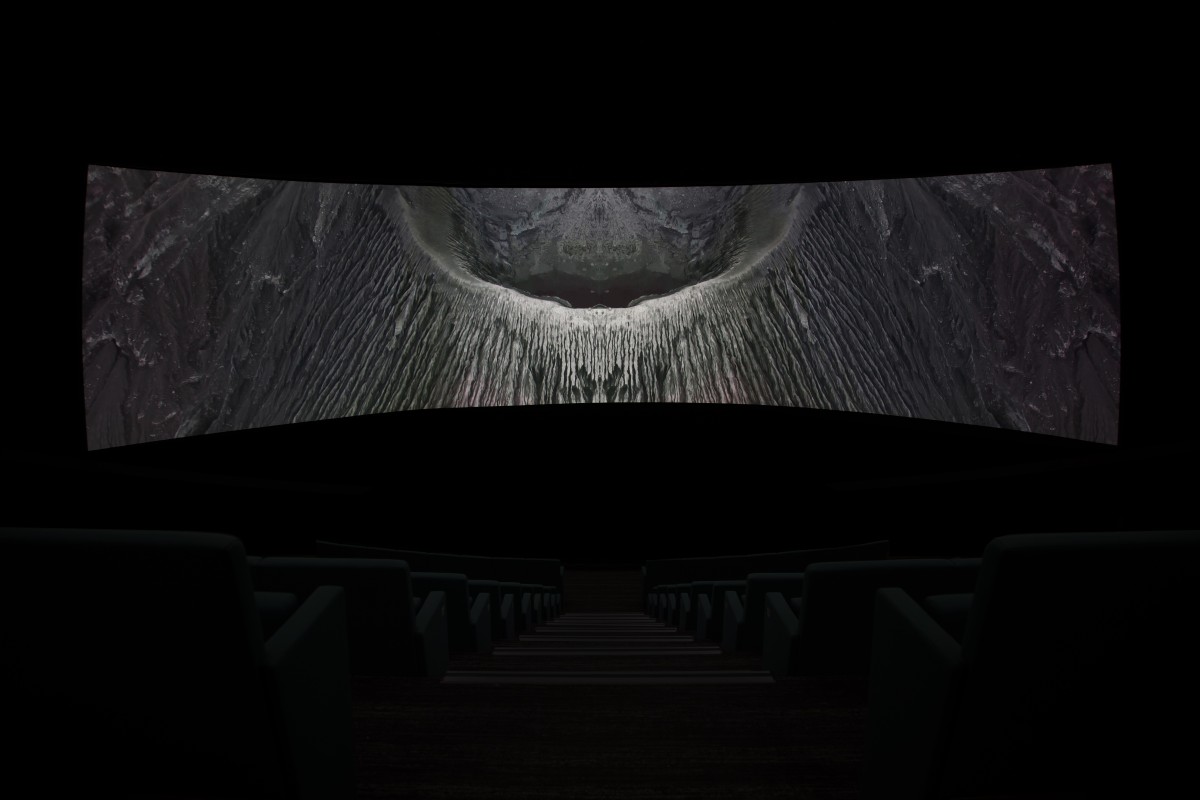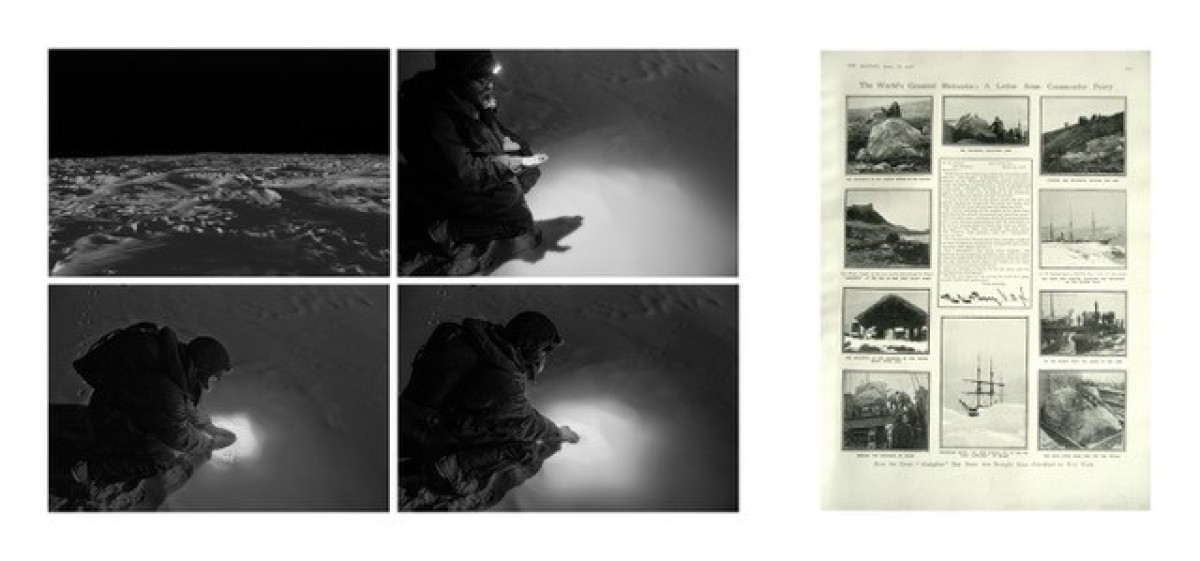Behind The Desert Turned to Glass
Charles Stankievech reveals the making of his cosmic exhibition at Contemporary Calgary.

Charles Stankievech, The Desert Turned to Glass, 2012/2023. Installation. Photo Courtesy: Studio Stankievech
On view now at the Contemporary Calgary inside its planetarium is The Desert Turned to Glass, an ambitious and pivotal exhibition by acclaimed Canadian artist Charles Stankievech. Forming a place where the cosmic and the underworld collide, the artist has transformed the gallery’s planetarium into an epic meditation on origins, endings, and infinity. Celebrating the invention of the planetarium, the transmedia installation fills both the projection room of the dome and the subterranean space below. Visitors experience a stratified ecosystem spread across three levels of the building, diving through concepts of space and time.
Exploring alternative theories of the origin of life, Stankievech reveals a new video work in the exhibition titled The Eye of Silence, which shows high atmospheric video recordings of the Albertan Badlands, the Utah Salt Flats, Icelandic and Japanese volcanoes, and a meteorite crater in the Namibian desert. Visualizing the Earth as it goes through various pivotal stages of its evolution, the presentation speculates about the moment when life on the planet was seeded from a frozen meteorite.
For a virtual viewing, watch the video tour of the exhibition below.
Wanting to learn more, we connected with Stankievech to dig into the making of his new work, his obsession with meteorites and using the Contemporary Calgary’s planetarium as the backdrop of his solo exhibition.
AGOinsider: What about the origins of life and meteorology fascinates you?
Stankievech: I think the fascination with origins is universal. Stories of Creation are evidence of this, whether it is an animal's action creating the world as shared by many animistic practices or the gods creating the world as a by-product of their actions or some ex nihilo act from a monotheistic God. Scientific narratives continue in this vein and are equally as creative. The Desert Turned to Glass participates in the same old-age practice.
Meteorites are so wonderful because they are something you can hold in your hands full of contradictions. It’s a rock, the simplest and most common thing on the earth, but they are not from the earth. It’s an inanimate object, yet might hold the secrets to the origin of life. And when we talk about deep time, we are talking really deep. They are the material evidence of the origin of the universe, the stars and failed planets. Our entire history is entwined with meteorites, from creation to eventual extinction (which has already happened to much life on this planet).
AGOinsider: What are your inspirations behind The Eye of Silence? How do your existing works respond or tie into it?
Stankievech: I’ve been working with meteorites for almost 15 years now, so the current show continues my obsession. I had been collecting them personally for a while, and then I professionally introduced them in my Ghost Rockets World Tour (2009) series of performances, where I launched 12 rockets around the world at specific points marking the history of ballistic weapons. With a mapping project that marked specific space-time coordinates where humans launched objects into outer space, I also looked at the inverse of where outer space objects hit the Earth. Meteorites are the ultimate site-specific works: they hit the Earth at a specific time and place. As such, they started becoming talismans for me in my work and the beginning of a theory of sculpture.
I started seeing how their cultural history and weaponization entwined with religion when I started to research for my essay Magnetic Anomalies in the Arctic: Colonial Resource Extraction, Meteoric Cults, and the Rare Earth Age along with my artwork Anabarium, both in 2015 for the exhibition Rare Earth and which gets further developed in The Eye of Silence. I also buried a Russian meteorite while embedded with the Canadian military at CFS Alert--the northernmost settlement in the world and spy station on Russia. I documented the performance and then paired it with an archival document of the extraction of the famous York Meteorite in Greenland sold to the NYC Natural History Museum.
Specifically, The Eye of Silence began in the middle of COVID with a commission called The Glass Key (2021) that launched the digital platform for the KW Institute for Contemporary Art in Berlin called the Last Museum (curated by Nadim Samman). In parallel, the online work had a real-world manifestation as a sound installation called La llave de cristal (viajeros espejo) (curated by Daniela Pérez Villa) for James Turrell’s architecture Tree of Light, which is an amphitheatre created out of a cenote (water filled cave) in the jungle in Yucatan, Mexico. I was looking at the comparative history of religions, tracing Robert Smithson’s ‘Travels in the Yucatan,’ and continuing the research on meteorites, which lead of course, to the local cenotes that were created because of the famous meteorite that impacted the area fracturing the entire peninsula and killing all the dinosaurs. This work became a series of site-specific concerts I started doing, including one in Lanzarote in a volcanic tube (curated by Dehlia Hannah). The images of the video came after the creation of the soundtrack and really stitched together the dynamic forces of the volcanic with the extraterrestrial forces of meteorites. On a grand scale, these two forces are probably some of the two main forces shaping the history of the planet and thus became the main forces in the video.
AGOinsider: Can you briefly describe your approach to using the planetarium as the setting for this exhibition? What were some things you wanted to achieve the most with the space?
Stankievech: First of all, the architecture is incredible. It’s a beautiful 1967 Brutalist building specifically designed to engage the stars. As with most of my institutional exhibitions, I embrace the uniqueness of the architecture, so instead of being bothered by the odd spaces, angles and volumes, these were elements to embrace. The show really took form when I conceived of creating an entire microcosm of our world in the building by presenting a stratified exhibition. Not only would the impressive projection dome create an outer space for the visitor (as is usually the case with planetariums), but directly underneath I could also create a subterranean world in dialogue. Here, a visitor was able to move between two dark spaces, the starry sky and the cavernous underworld — two places they don’t usually get to explore. I also tangibly connected the spaces through sound. We placed massive subwoofers in the basement cave area that played only the lower frequencies of the film played upstairs in the dome. So in effect, while hanging out underground, you heard the rumble of the film above, shaking the architecture and floor as if the Earth was shifting its tectonic plates.
It’s fun to mention this show was a homecoming for me. I grew up in a small town outside of Calgary, so I recall visiting this exact planetarium as a child and participating in the High School Science Olympics hosted in the building. I still love planetariums and Natural History museums, but they sometimes overload you with information. I’m also against dumbing down science for a popular imagination. So I hope with this show, I offer something else -- a deeply intuitive and visceral experience grounded in contemporary scientific research. Art encourages us to experience the world around us with all of our senses in an immersive, poetic way. And to be fair, I’m not exactly sure what people will learn from the show; and that’s okay because there isn’t a specific lesson. Too much of our world today -- from art to politics -- forces us to accept simple answers. I want to present a sublime world and speculate about possibilities. Even planetariums usually present astounding answers. I’m hoping the show gets people to start asking unanswerable questions.
AGOinsider: You brilliantly divided the exhibition into three parts: Cosmic, Collision and Chthonic. How would you recommend visitors engage with them individually and with each other?
Stankievech: The answer to a question about space is naturally about time. There is no order to the show, but each level does need to be engaged slowly.
Cosmic: The film is a slow psychedelic flying over the face of the earth showing it age geologically from fresh volcanic fields to the oldest desert in the world. As a narrative, it takes half an hour to go from the Hadean period to us flying into a cave to see prehistoric petroglyphs. Michael Snow (a late friend and really the forerunner of the type of work I do) made a 15-minute version of Wavelength, so people didn’t have to wait the full 45 minutes to watch his original version. I figure a 30-minute film of the Earth aging is short compared to the few billion years it actually took. Loosing yourself in the soundtrack, and forgetting any sense of time is the best way to experience the Cosmic.
Collision: The great thing about the work on this level is you experience it while spiralling around it, moving between the floors on a spiral ramp. While the meteorite is floating and spinning, you, the visitor, are forced to circle it as you navigate the exhibition. In a sense, I again help the viewer “cheat” time. I’ve frozen the moment before the meteorite hits the earth and extended it indefinitely. In this way, the viewer is moving inside frozen time and, relatively, each second that passes looking at the work is infinitely long in reality.
Chthonic: For safety reasons, we are asking people to enter the subterranean space slowly as it takes about 5 minutes for one’s eyes to adjust and be able to navigate the incredibly dark space. “Nothing” really happens in this space, which inversely means you need to hang out for a long time to experience what it is about. When you settle and let the work emerge, you’ll smell the crude oil, hear the rumbling sound, and feel the vibrations as they ripple the black surface of the pool and under your feet. Eventually, if you walk to the back of the gallery, you’ll face a pitch-black cave. Stare into the darkness and see what you see.
It’s pretty much impossible to photograph The Dark Side of the Sun (the title for the expansive black pool) because it functions much like a Zen dry garden. We shot half the film while working in Japan, and as the Head Priest Takafumi Zenryu Kawakami of the Zen Shunkoin Temple told me in one of our mediation sessions, it’s difficult to photograph Zen gardens because it’s not about the rock or the tree as an object, but about the spaces in between (an interview with him is forthcoming in a book related to the show with Hajte Cantz). I hope people will slow down and be still in what seems like an intimidating underworld at first, but when one becomes comfortable with the darkness, life starts to appear. The black pool is alive with bacteria, and in the back of the room is an ultrasonic sound installation for bats. While at first, it seems dark and empty, the space is actually teaming with activity, and if one slowly dwells in it, the complexity of the work starts to emerge.
The Desert Turned to Glass by Charles Stankievech is on view at the Contemporary Calgary through May 7, 2023.



